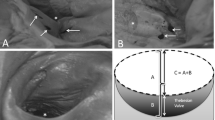Abstract
This report describes a phenomenon observed during implantation of a left ventricular lead through the coronary sinus. During coronary sinus venography there was reflux of dye from the coronary sinus ostium towards the distal part of the sinus against the anticipated direction of flow. This was correlated to elevation of the right atrial pressure above the pressure within the coronary sinus. A review of data is provided and suggests several deleterious effects of this phenomenon on left ventricular function.
Similar content being viewed by others
References
Berland J, Farcot JC, Barrier A, Dellac A, Gamra H, Letac B. Coronary venous synchronized retroperfusion during percutaneous transluminal angioplasty of the left anterior descending artery. Circulation 1990;81:35–42.
Toggart EJ, Nellis SH, Leidtke AJ. The efficacy of intermittent coronary sinus occlusion in the absence of coronary sinus collaterals. Circulation 1987;76:667–677.
Mohl W, Faxon D, Glogar D, Gore JM, Jacobs A, Mai D, Meerbaum S, Moser M, Juhasz -Nagy A, Punzengruber C, Raberger G, Roberts A, Tritthart H, Winters ZE, Wolner E. Report of the international working group on coronary sinus interventions. In Mohl W, Faxon D, and Wolner E. (eds.) CSI-A. New approach to Interventional Cardiology, New York: Springer- Verlag, 1986, p. 2–10.
de Cock, van Campen, Visser. Major dissection of the coronary sinus and its tributaries during lead implantation for biventricular stimulation: Angiographic follow-up. Europace 2004;6(1):43–47.
Yu, Tune, Downey. Elevated right atrial pressure does not reduce collateral blood flow to ischemic myocardium. Am J Physiol 1997;273:H2296–H2303.
Ward, Fisher, Michael. Elevated coronary sinus pressure does not alter myocardial blood flow or left ventricular contractile function in mature sheep. Implications after the Fontan Procedure. J Thorac Cardiovasc Surgery 1988;95(3):511–515.
Ido, Hasebe, Matsuhashi, Kikuchi. Coronary Sinus occlusion enhances coronary collateral flow and reduces subendocardial ischemia. Am J Physiol Heart Circ Physiol 2001;280:H1361–H1367.
Farhi ER, Klocke FJ, Mates RE, Kumar K, Judd RM, Canty JM Jr, Satoh S, Sekovski B. Tone dependent waterfall behavior during venous pressure elevation in isolated canine hearts. Circ Res 1991;68:392–401.
Uhlig PN, Baer, RW, Vlahakes, GK, Hanley FL, Messina LM, Hoffman JIE, Arterial and venous coronary pressure flow relations in anaesthetized dogs. Evidence for vascular waterfalls in coronary veins. Cardiovasc Res 1984;55:238–248.
Matsuhashi H, Hasebe N, Kawamura Y. The effect of intermittent coronary sinus occlusion on coronary sinus pressure dynamics and coronary arterial flow. Jpn Circ J 1992;56:272–285.
Uhlig, Baer, Vlahakes, Hanley, Messina, Hoffman. Arterial and venous coronary pressure-flow relations in anesthetized dogs. Evidence for a vascular waterfall in epicardial coronary veins. Circ Res 1984;55(2):238–248.
Ratajczyk-Pakalska E, Kolff WJ. Anatomical basis for the coronary venous outflow. In The Coronary Sinus, Mohl W, Wolner E, and Glogar D. New York: Springer- Verlag, 1984, p. 40–46.
Scharf Sm, Bromberger-Barnea B, Permutt S. Distribution of Coronary venous flow. J Appl Physiol 1971;30:657–662.
Sestier, Mildenberger, Klassen. Redistribution in left ventricular regional blood flow following acute right ventricular pressure overload. Can J Physiol Pharmacol 1978;56(2):185–190.
Ryan T, Petrovic O, Dillon JC, Feigenbaum H, Conley MJ, Armstrong WF. An echocardiographic index for separation of right ventricular volume and pressure overload. J Am Coll Cardiol 1985;5(4):918–927.
Zamorano J, Almeria C, Alfonso F, Angeles Perez M, Grauper C, Morales R, Sanchez-Harguindey L. Transesophageal doppler analysis of coronary sinus flow a new method to assess the severity of tricuspid regurgitation. Echocardiography 1997;14(6 Pt 1):579–588.
Neri E, Tripodi A, Tucci E, Capannini G, Sassi C. Dramatic improvement of LV function after coronary sinus thromboembolectomy. Ann Thorac Surg 2000;70(3):961–963.
Davis KL, Mehlhorn U, Laine GA, Allen SJ J. Myocardial edema, left ventricular function, and pulmonary hypertension. Appl Physiol 1995;78(1):132–137.
Pratt JW, Schertel ER, Schaefer SL, Esham KE, McClure DE, Heck CF, Myerowitz PD. Acute transient coronary sinus hypertension impairs left ventricular function and induces myocardial edema. Am J Physiol 1996;271(3 Pt 2):H834–H841.
Author information
Authors and Affiliations
Rights and permissions
About this article
Cite this article
Verma, S. Coronary Sinus Flow Reversal in Congestive Heart Failure Detected During Biventricular Pacing. J Interv Card Electrophysiol 14, 45–49 (2005). https://doi.org/10.1007/s10840-005-4062-z
Received:
Accepted:
Issue Date:
DOI: https://doi.org/10.1007/s10840-005-4062-z




